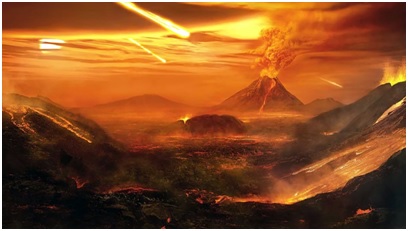The history of life on Earth has always been interesting. How life adapted, evolved, and eventually became what we know today. What stages the Earth went through to become the ‘Blue Marble’ that has been with us for millions of years. Since this topic is so fascinating (To me, at least), I decided to write a blog about them. The Ancients is the name I’ve given for the series of blog posts I’ll write about Earth’s history. This is the first. So, without further ado, read on to learn some things! (Hopefully.)
Quick info:
Name : Hadean
Duration : 4560 – 4000 m.y.a*
Average Temperature : 70-2100 Celsius
Atmospheric oxygen : 0%

Everyone knows how the Earth and other planets were formed. Groups of rocks orbiting the Sun; They crash into each other; Bam, you got planets. Most people also know that the Earth was a molten, hot landscape, with no water or life. But, how did that become the life-bearing, blue Earth we know today? Well, first you need to understand how a planet can have life.
In a solar system, there is a belt in the orbits called the Habitable Zone. There, a planet has the right conditions for life. This is where our Earth ended up. (Duh, otherwise we wouldn’t exist.) Now, this rocky, molten, volcano-y part of Earth’s History is known as the Hadean eon. The average temperature there was a warm (approximately) 1900 degrees Celsius (And by warm, I mean hot enough to evaporate practically anything). And of course, there was no oxygen. Oxygen wouldn’t exist for another 500 million years. This was the earliest time in Earth’s history, where it collided with LITERALLY EVERYTHING. That’s why everything was so hot. The surface was covered with volcanoes which constantly erupted, and meteorites and comets kept hitting the surface. Earth had an atmosphere, but due to the frequent collisions, it kept getting lost.
The meteorites and comets brought materials to the Earth. The comets brought something extremely important: water. The water was stuck in a constant (probably painful) loop. Clouds would form, fall as rain, then the rain would evaporate before it even hit the ground, then form clouds again. The meteorites brought carbon, which is an essential part in forming life. Now, the discovery of these carbon minerals (In Australia, no less) made scientist think that life may have arisen multiple times, but got wiped out by, you know, the CONSTANT VOLCANO ERUPTIONS. Also, the existence of organic particles – that is, carbon- in meteorites may be evidence that life exists outside Earth. Not laser-gun wielding, spaceship-driving life, but life, nonetheless.
Don’t worry though. The Hadean eon is far behind us. Like, FAR behind us. How far? Oh, I don’t know, about 4,500 MILLION years ago.
*million years ago
Shaurya Prasad (Grade 7A)